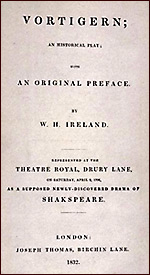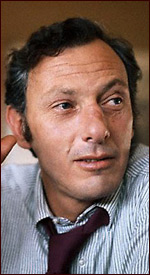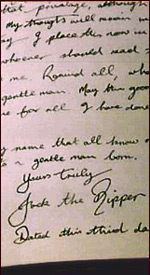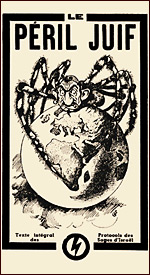|
The art of forging literary and historical documents is nearly as old as
writing itself. Two thousand years ago, early practitioners put reed pens to
papyrus to mimic the writing of Socrates and other ancient authors whose work
was highly valued. Today, the motive of most forgers remains the
same—create something "priceless," then find a sucker willing to pay an
exorbitant price. Yet as this collection of famous fakes illustrates, sometimes
the forger's aim is not profit but power, and even a crudely executed forgery
like the Protocols of the Elders of Zion can have devastating, long-term
consequences. To learn the details of this and other cases, click on the links at right or simply scroll down through the gallery of forgeries.—Susan K. Lewis
 |
 |
 |

A medieval fresco at the Church of Santi Quattro Coronati in Rome depicts
Constantine's generous, but fictitious, donation.

| |
Donation of Constantine
This ancient letter, which helped bolster the Catholic Church's power for
roughly 700 years, was probably the first forgery to significantly impact the
course of history. Allegedly sent by the Roman emperor Constantine the Great to
Pope Sylvester I in the fourth century A.D., the letter testifies to the
emperor's conversion to Christianity and grants vast authority to the pope and
his successors. Among other privileges, the emperor gives the pope dominion
over "Rome and the provinces, districts, and towns of Italy and all the Western
regions."
Constantine's conversion is an historical fact, but the letter is a pure
fabrication. While its origin is debated, the Donation was likely
concocted between A.D. 750 and A.D. 850, perhaps by a church official. Various
popes used it over the ensuing centuries to defend their political power, and
the Donation was even celebrated in a painting in the Vatican. It was
revealed as a fake in the 15th century.
|

In the preface to this 1832 edition of the script, Ireland admits his guilt.

| |
Shakespeare's Lost Play
After passing off as genuine what were counterfeit fragments of the scripts of Hamlet and
King Lear he claimed were penned by the bard himself, late 18th-century
forger William Henry Ireland became foolishly daring. He announced the
discovery of a completely unknown Shakespeare drama called Vortigern.
Thrilled by the thought of a new Shakespeare, a renowned theater producer
signed on to premier the play at Drury Lane. But when Ireland handed over the
text, his game was up. The producer quickly came to suspect that the hackneyed
script was written by Ireland himself. Not only did he refuse to bill it as a
Shakespeare original, but he planned to stage the play as an April Fool's Day
joke—along with a musical farce about the gullibility of an art
collector. The play eventually premiered a day late, on April 2, 1796.
|

The unknown author made little attempt to match Lincoln's handwriting, let
alone his refined prose.

| |
Lincoln's Love Letters
The stumbling, awkward English in this exchange of letters would have
horrified Abraham Lincoln, a master of prose with impeccable grammar. The
letters are supposedly between Lincoln and his real-life clandestine love Ann
Rutledge. In them, "Beloved Ann" professes, "if you git me the dictshinery...I
no I can do both speeking and riting better...my hart runs over with hapynes
when I think yore name..." While slightly more literate, "Lincoln's" letter to
Rutledge is peppered with anachronisms and signed "yours affectionately,
Abe"—a nickname the proper Mr. Lincoln abhorred.
Despite the crude nature of the forgeries, The Atlantic Monthly
published a series of articles based on them entitled "Lincoln the Lover: The
Courtship," in January 1929. As soon as the articles went to press, several
Lincoln scholars, including biographer Carl Sandburg, identified the letters as
outlandish fakes.
|

Newsweek proclaimed in its May 2, 1983 issue that the "secret diaries" could
"rewrite history."

| |
Hitler's Diaries
Kenneth Rendell, a dealer in historical documents who helped unmask the
Hitler diaries, called them "bad forgeries but a great hoax." The hoax began in
1981, when a reporter for the German magazine Stern caught wind of
diaries recovered from a Nazi plane crash and stowed away for decades. Over 50
journals, purportedly handwritten by Hitler, revealed a kinder, gentler
dictator whose "final solution" to the "Jewish problem" was not genocide but
merely the deportation of Jews.
Stern hired experts to authenticate the diaries but gave them only a few
select pages to review. Even worse, many of the examples of "genuine" Hitler
documents Stern provided for comparison were from the same dealer who
had proffered the diaries. They were, of course, all in the same
hand—that of the forger.
When Stern broke the story of the diaries in late April of 1983, it
triggered banner headlines around the world. But they were soon revealed as
fakes. At his trial, forger Konrad Kujau, a German dealer in military
memorabilia, openly admitted guilt and gladly signed Hitler "autographs" for
the crowd.
|

Clifford Irving, photographed in February 1972, as his forgery scheme was
unraveling.

| |
Howard Hughes's Autobiography
Even the most brazen forgers don't usually ape the writing of a living
subject. But Clifford Irving went even further, composing an entire
"autobiography" of Howard Hughes in 1971 while Hughes was still alive. Irving
miscalculated that the reclusive 65-year-old billionaire, who hadn't appeared
in public since 1958, would be too ill to step forward and call his bluff.
Together with his wife Edith, Irving forged not only the autobiography but also
correspondence with Hughes discussing the book and various legal documents. The
contract Irving and "Hughes" signed with McGraw-Hill guaranteed an advance of
$750,000 for the manuscript.
Just before the book was to be published in 1972, the real Hughes did come
forward—if not in person at least in a telephone call with
reporters—to expose the fraud. Irving was sentenced to two and a half
years in prison, but he later cashed in on his escapades with an authentic best-seller entitled The Hoax.
|

Details in the diary hinted that "Jack the Ripper" was James Maybrick, a
Liverpool cotton merchant and arsenic addict.

| |
Jack the Ripper's Diary
A publicity brochure for The Diary of Jack the Ripper declared
October 7, 1993 "the day the world's greatest murder mystery will be solved."
On that day the book, which already had advanced sales of over 200,000 copies,
would be available to countless fans of the true-crime genre in England, the
U.S., Australia, continental Europe, and Japan.
The gruesome diary's author wrote, "I place this now in a place where it shall
be found," yet it apparently took more than 100 years for it to emerge. In
1992, an Englishman named Mike Barrett announced he had acquired the diary from
a deceased friend and had deduced the real identity of its author.
When forgery expert Kenneth Rendell analyzed the diary, he was struck by the
handwriting style, which seemed more modern than Victorian. It was written in a
genuine Victorian scrapbook, but 20 pages at the front end had been torn out,
as if a forger had removed pages used by the scrapbook's original owner.
Rendell and other experts ruled the diary a fake, but the book's British
publisher went ahead with its release, noting the diary's dubious authenticity
only on the dust jacket.
|

Mussolini strikes a pose before an Italian audience in 1934. His forged
diaries had a similarly forceful and convincing style.

| |
Mussolini's Diaries
One of the experts who authenticated the diaries of Italian dictator Benito
Mussolini when they emerged in 1957 was emphatic: "Thirty volumes of
manuscripts cannot be the work of a forger," he declared. "You can falsify a
few lines or even pages, but not a series of diaries." Yet an Italian woman
named Amalia Panvini, aided by her 84-year-old mother, had done just
that—producing masterful forgeries that fooled even the dictator's son,
Vittorio.
Italian police confiscated most of Panvini's prolific output. But 11 years
later, despite the widely publicized forgery case, the Sunday Times of
London purchased four remaining volumes for a sizeable sum. Fortunately, the
Times's editors caught their mistake before publishing the fakes.
|

The Protocols have spurred anti-Semitism in many different languages
over the decades.

| |
Protocols of the Elders of Zion
Hitler and his fellow Nazis used a preposterous forgery from
late-19th-century Russia as a brutal weapon of propaganda against the Jewish
people. An agent of the Imperial Russian secret police had devised the
Protocols in the 1890s both to demonize Jews and to target Russia's
minister of finance, Sergei Witte, whose policies threatened many conservative
Russians. The Protocols link Witte with a Jewish conspiracy to
destabilize governments and take over the world, a mission supposedly plotted
at a clandestine meeting among Jewish leaders in Basel, Switzerland in 1897.
The Protocols, the "minutes" from this fictitious meeting, were first
published in full in Russia in 1905, but tens of thousands of copies soon
spread throughout Europe and the U.S. In August 1921, the London Times
exposed the Protocols as a forgery, but this didn't stop Hitler and
other anti-Semites from using it as fuel in their war of hatred. Joseph
Goebbels, who helped orchestrate the Nazi propaganda campaign, had the
Protocols translated into many languages and widely distributed. Even
today, the infamous forgery remains in circulation among the Ku Klux Klan and
neo-Nazi groups, and it continues to inflame anti-Semitism around the world.
|

| 
|

